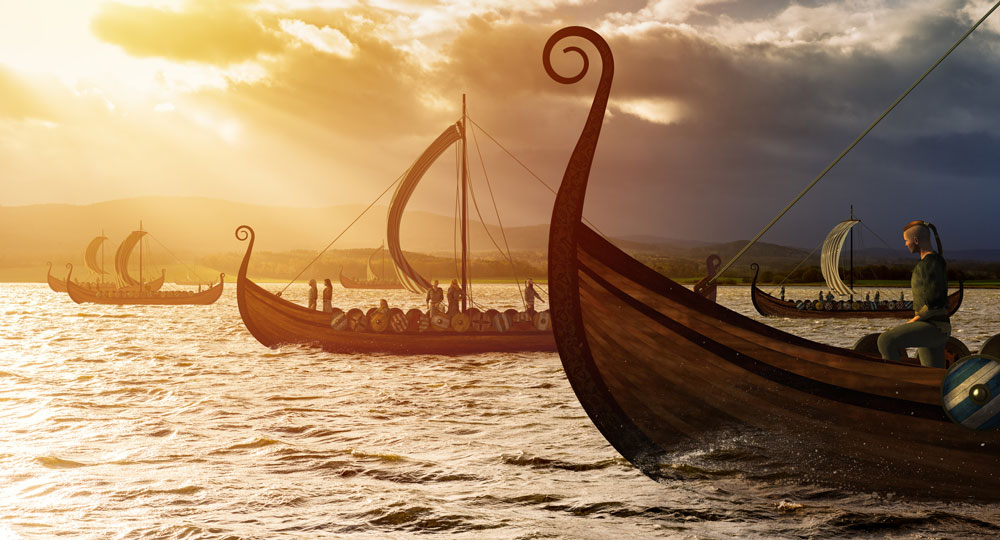
Teaching About the Viking Age is Relevant - and Even Crucial says MLCS Associate Professor & Henry Cabot and Linnea Lodge Scandinavian Professor Natalie Van Deusen
I feel a bit like an imposter, writing for the Canadian Historical Association blog, as I am not actually a historian. My PhD (2012, University of Wisconsin-Madison) is in Scandinavian Studies, with a minor in Medieval Studies. I am a textual philologist and a specialist in literature from medieval and early modern Iceland, especially hagiography and religious literature. I have published two books and a number of articles on the composition, reception, and transmission of Old Norse and early modern Icelandic lives of saints in prose and poetry. So, while I am not a historian per se, I am routinely immersed in the language, literature, and culture of the past, in my research as well as in my teaching.
I have been a professor of Scandinavian Studies at the University of Alberta for over seven years now. Like many others in my field in North America, I teach a wide variety of courses on Scandinavian language, literature, and culture from the Middle Ages to the present. I also teach Old Norse language. However, none of the courses I offer are more popular than my courses on Norse mythology, the Viking Age, and the Icelandic sagas (all taught in English translation). These courses are consistently near or at capacity, and attract students from across campus and from a wide variety of academic disciplines. I am thrilled that so many students have chosen to take my courses on historical contexts that are far in the past, and I have come to appreciate the importance, challenges, and promises of teaching such content in a contemporary context.
One of the most pressing reasons for teaching the Viking and medieval Norse past (and the European Middle Ages more generally speaking) is the grim reality that white supremacist and racist/tribalist neo-pagan groups--like the Nazis a century before them--frequently utilize medieval imagery and are motivated by their belief in a "white" medieval past and a "pure" ancestral race they perceive as under threat in the face of immigration and religious and racial diversity. The Viking Age and Norse mythology are of particular interest in these groups, who have committed acts of violence against perceived "outsiders" (Jews, Muslims, people of color).
For this reason, it is absolutely essential that researchers and teachers of the Viking and medieval Norse past and the European Middle Ages more broadly work to combat dangerous misconceptions about racial and ethnic homogeneity. I strive to teach the religion and culture of the Viking Age and Nordic Middle Ages in a way that does not solely focus on Norse-speaking peoples, who were by no means the only ones to occupy the Nordic region during this period, nor were they without influence from surrounding cultures. Recent research on religion in the Viking Age has demonstrated the many ways in which the belief systems of Norse-speaking peoples and the Sámi (the indigenous peoples of northern Scandinavia), Finno-Baltic, and Greenlandic Inuit populations mutually influenced one another and engaged in what Thomas A. DuBois calls "a dynamic process of religious exchange" (Nordic Religions in the Viking Age [Philadelphia: University of Pennsylvania Press], p. 137). I teach the Icelandic saga literature with an increased awareness of and scrutiny towards portrayals of the religions and cultures outside of the Scandinavian homeland. I also incorporate within a historical overview of the Viking Age accounts from diverse sources ranging from England to northern Iberia, and drawing upon the findings of recent archaeological research and DNA analysis, which debunks the myth of an ethnically "pure" Viking Age (see Vikings were never the pure-bred master race white supremacists like to portray). Finally, I provide students with an introduction to the inclusive heathen groups who venerate the Norse pantheon and routinely work to combat exclusivist ideologies in their universalist religious practices.
The challenges posed by teaching the Viking and medieval Norse past therefore create exciting opportunities for helping students deepen their understandings of the past and how it is currently being reinterpreted--both in scholarship and among inclusive and universalist heathen practitioners. This underscores the promises of doing this kind of work, and highlights the ways in which studying the past can help us understand our present. Indeed, teaching the Viking and Nordic Middle Ages allows for an exploration of a number of other topics of relevance to students' daily lives, including gender, class, sexuality, ability, and race. By studying these concepts within a historical framework, we are able to reflect in a unique way on our contemporary societies and experiences, as well as individual and cultural understandings and biases. We are able to examine and think critically about the ways in which ideas have changed or evolved, and create a meaningful link between the present and the past that inevitably informs it.
This article originally appeared in the Canadian Historical Association (November 25, 2019)
Natalie Van Deusen is an Associate Professor & Henry Cabot and Linnea Lodge Scandinavian Professor in the Department of Modern Languages and Cultural Studies